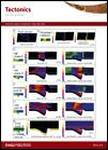版权所有:内蒙古大学图书馆 技术提供:维普资讯• 智图
内蒙古自治区呼和浩特市赛罕区大学西街235号 邮编: 010021

作者机构:Acad Sci Inst Geophys Prague Czech Republic Nation Acad Sci Ukraine Subbotin Inst Geophys Kiev Ukraine
出 版 物:《TECTONICS》 (大地构造)
年 卷 期:2019年第38卷第11期
页 面:3818-3834页
核心收录:
学科分类:0709[理学-地质学] 081803[工学-地质工程] 07[理学] 08[工学] 0708[理学-地球物理学] 0818[工学-地质资源与地质工程]
主 题:Electrical conductivity magnetotellurics modeling and inversion Ukrainian Eastern Carpathians
摘 要:We present results of a study of the electrical conductivity distribution beneath the Ukrainian Eastern Carpathians where the Carpathian arc turns to the southeast and reaches the maximum curvature further in the Romanian territory. We have used the magnetotelluric and magnetovariational data in the period range of 1-6,000 s collected by geoelectric groups from several countries during deep induction experiments, which covered the studied area by a number of field stations clustered along profiles crossing the Carpathian arc. In this work, we compare the 2-D and quasi-3-D thin sheet inverse models, which allow us to constrain both the geometry and electrical properties of the anomalous conductivity structures beneath the Carpathians. Comparison of the inverse results with the Carpathians tectonics indicates that the Carpathian conductivity anomaly within the Polish and Slovak territory is located approximately between the Magura nappe front and the Pieniny Klippen Belt. In Ukraine, where the Magura nappe narrows and disappears, the anomaly reaches the front of the Outer Carpathians. The resulting quasi-3-D model of the conductivity structure beneath the Carpathians is compared with other geophysical and geological data within the region. The relation of the position of the conductors to the heat flow models and to location of the earthquakes sources indicates possible geological mechanisms, such as saline pore fluids, thin films of grain boundary graphite, or partial melting, connected with recent activation zones.